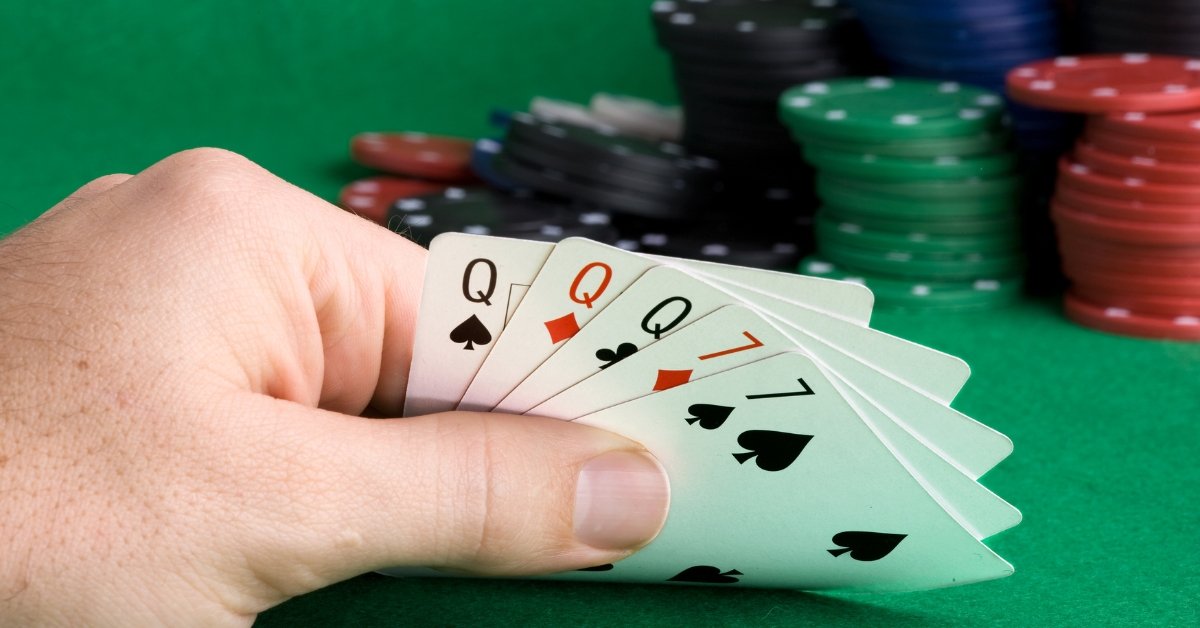Table Of Contents
Poker is a thrilling game that combines skill, strategy, and a small amount of luck.
The whole house is powerful and exciting among the various hands that can shape your game.
However, what exactly is an entire house in poker?
Let us dive into the details, exploring its definition, ranking, and strategies to leverage it effectively.
What Is A Full House In Poker?
In poker, a whole house is a hand consisting of three cards of one rank and two cards of another.
For example, if you have three Queens and two 7s, your hand is a whole house, often called “Queens full of Sevens.”
It is one of the higher-ranking hands in poker, making it a sought-after combination.
Why Is It Called A “Full House”?
The term “full house” originates from the idea that the hand is “full” of one rank (three cards) while “housing” another (two cards).
This combination symbolizes a strong and complete hand.
The name has stuck over time because it succinctly captures the essence of the hand: a balanced yet dominant combination.
Full House Rankings: Where Does It Stand?
In standard poker hand rankings, a full house ranks above a flush and below four of a kind.
Here is a quick breakdown of the rankings:
- Royal Flush
- Straight Flush
- Four of a Kind
- Full House
- Flush
- Straight
- Three-of-a-Kind
- Two Pair
- One Pair
- High Card
If two players have a whole house, the one with the higher three-of-a-kind wins.
For instance, a hand of Kings full of 10s beats a hand of Jacks full of Aces because the three Kings outrank the three Jacks.
In the rare case where the three-of-a-kind is the same, the higher pair determines the winner.
How A Full House Works In Texas Hold ’em
In Texas Hold ’em, the community cards are crucial in forming hands.
Let us explore a couple of scenarios where a whole house might arise:
Example 1: “Board Completes The Full House”
Imagine you’re holding 9♥, 9♠ and the community cards are 9♣, 7♦, 7♥, 3♠, K♣.
You have hit a full house with three 9s and two 7s.
The board helps complete your hand, making it a strong contender.
Example 2: “Opponent’s Hand Builds The Tension”
You hold K♠, K♣, and the community cards are K♥, 4♦, 4♣, 8♠, Q♥.
You have formed a full house (Kings Full of Fours) here. However, be cautious: if an opponent has pocket 4s, they will have a stronger full house (Fours full of Kings).
Practical Tips For Recognizing And Playing A Full House
- Read the Board: The board cards can make or break your hand in games like Texas Hold ’em. Be mindful of combinations that might improve your opponents’ hands.
- Adapt Your Strategy: If the board pairs (e.g., two 7s on the flop), consider the possibility of a full house forming for you or others.
- Value Betting: When you suspect your entire house is the best hand, strategically increase the pot size by betting on each street.
Interactive Exercise: Can You Spot The Full House?
Try this quiz: You hold Q♠, Q♥, and the community cards are Q♦, J♣, J♥, 10♠, 2♦.
Do you have a full house? If so, what is the exact name of your hand?
Answer: Yes, you have Queens full of Jacks.
Practice identifying full houses with different starting hands to sharpen your skills!
Conclusion
A whole house is a game-changing hand in poker that can lead to significant wins when played strategically.
Whether you are a beginner or a seasoned player, understanding its nuances can give you an edge.
Beyond its power, the thrill of landing a whole house often makes poker games unforgettable.
If you found this guide helpful, explore our website for more poker strategies, tips, and tricks.
From mastering bluffing to understanding odds, we have got you covered.
Poker is a blend of skill, strategy, and patience—so keep learning and playing!
Trivia: Did You Know?
The odds of being dealt a whole house in a 5-card poker game are 1 in 693, making it a relatively rare but achievable hand. However, in a 7-card poker game, the odds of completing a full house increase to about 1 in 37.5, thanks to the additional cards dealt. Entire houses are more common in Texas Hold ’em than in traditional 5-card draw.






